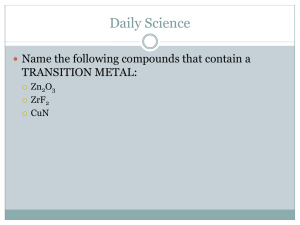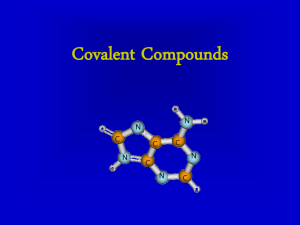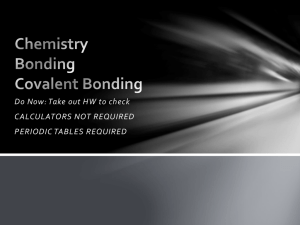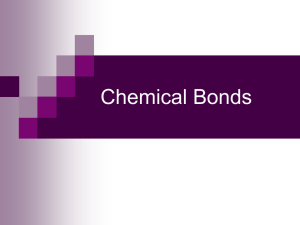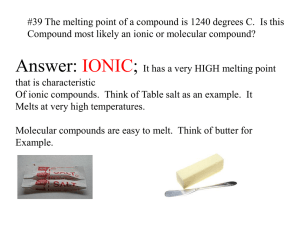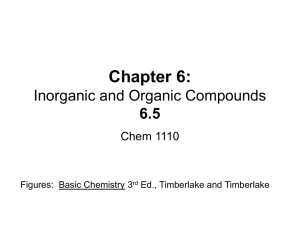Covalent Bonds
advertisement
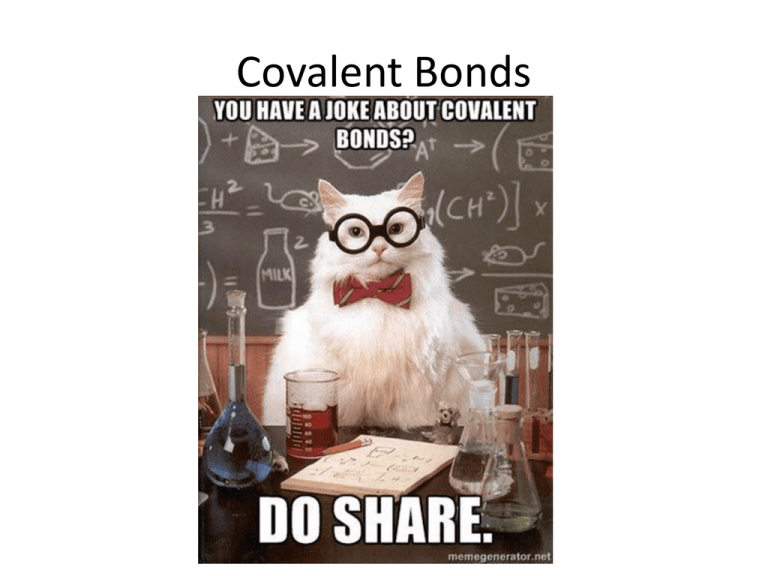
Covalent Bonds Bonding Atoms - Review • Why do atoms bond? • Each atom wants a full outermost energy level • How do they do this? – By gaining, losing, or sharing valence electrons to achieve octet rule aka: “being happy or stable” – Gives each atom an electron configuration similar to that of a noble gas Types of Bonding • Ionic Bond – Gives / Takes Electrons – One atom will give an electron to another atom • Covalent Bond – Share electrons – Two elements will share electrons between them so they are both “happy” / stable • Polar Bond – We aren’t going to cover Covalent Bonds • A chemical bond in which two atoms share a pair of valence electrons • Always formed between nonmetals Steps to Covalent Bonds • Step 1: Draw the Bohr Model OR the Lewis Dot Diagram • Step 2: Put circles around the electrons that are being shared • Step 3: Redraw the diagrams replacing the circled dots with lines • Step 4: Write the compound Step by Step Covalent Example • Hydrogen and Hydrogen – Step 1: Draw the Bohr/ Lewis Dot Diagram – Step 2: Put a circle around the shared electrons – Step 3: Replace the circle with a solid line – Step 4: Write the completed compound H2 Practice Problem • Hydrogen and Oxygen – Hydrogen needs 1 additional electron to fill its outer shell • It only have 1 to share • THEY MUST SHARE EQUAL NUMBERS – Oxygen needs 2 more electrons to fill its outer shell – ** This tells us that one hydrogen isn’t enough Hydrogen and Oxygen • Step 1/2: • Step 3: • Step 4: Covalent Bonds • Single Bonds – One electron is shared between 2 elements • Double Bonds – Two electrons are shared between 2 elements • Triple Bonds – Three electrons are shared between 2 elements Double Bond Example • Oxygen and Oxygen – Both have 6 electrons and NEED 2 more – They can both share 2 • Step 1/2 • Step 3 • Step 4 Two Types of Covalent Bonds • Diatomic – Two of the same elements are bonded – Aren’t found alone. Always found together or bonded to other elements – ONLY the following •H O N Cl Br I F • Polytomic – More than 2 elements are bonded together https://www.youtube.com/watch?v=QIfTT-_-xLo Characteristics of covalent compounds • • • • Low melting and boiling points Solubility and electrical conductivity Do NOT dissolve well in water. At room temperature covalent substances are gases, or liquids or low melting point solids. Naming Covalent Compounds • Look at the 1st Element – If only 1 – just use the element name – If more than 1 – use the correct prefix • Look at the 2nd Element – If its an element use the chart above – If it’s a compound use the compound chart Naming Covalent Compounds • Prefix System prefix mono di tri tetra penta hexa hepta octa nona deca # of atoms (1) (2) (3) (4) (5) (6) (7) (8) (9) (10) Polyatomic Ions Cont. • Common Polyatomic Ions Name the following compounds 1. SiO2 2. PBr3 3. CI4 4. N2O3 Naming Covalent Compounds Cont. Naming covalent compounds from formula 1. SiO2 = Silicon dioxide 2. PBr3 = Phosphorus tribromide 3. CI4 = Carbon tetraiodide 4. N2O3 = Dinitrogen trioxide Writing Formulas for Covalent Compunds Writing formulas from names 1. Carbon Dioxide CO2 2. Dinitrogen Pentoxide N2O5 3. Triphosphorus monosulfide P3S 4. Sulfur Monobromide SBr

